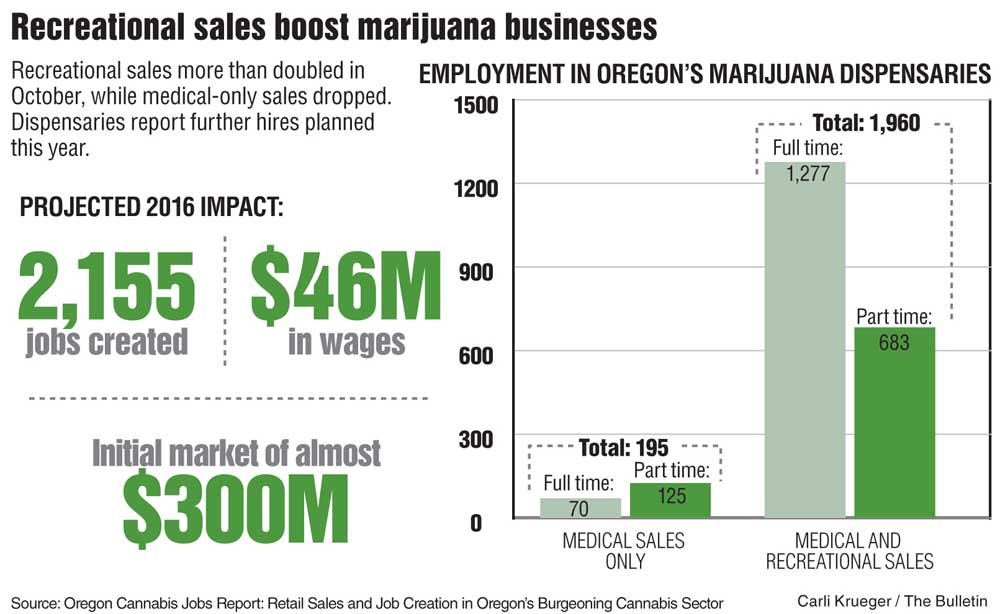Rec marijuana sales a big boost to Oregon medical dispensaries
Published 12:00 am Friday, April 15, 2016

- Rec marijuana sales a big boost to Oregon medical dispensaries
Ben Hebert needs no wide-ranging survey to tell him business was pretty good in October.
Looking at his sales records, the owner of Dr. Jolly’s Medical Cannabis, on SE Third Street, in Bend, confirmed Thursday what a white paper issued this week by marijuana business consultants showed: Consumers of recreational marijuana boosted sales at Oregon medical marijuana dispensaries that month by 112 percent for a total of $23 million. Median monthly dispensary sales went from $23,000 in September to $58,000 in October, the first month of legal sales of recreational marijuana in Oregon.
Hebert, whose dispensary is one of 19 operating in Bend, declined to state a specific figure but said sales doubled that month at Dr. Jolly’s.
“I think marijuana sales will continue to grow,” he said, “especially as we continue to scale, the price will come down. We’ll be able to produce better marijuana cheaper.”
The Oregon Cannabis Jobs Report, released Tuesday by Sam Chapman of New Economy Consulting and Beau Whitney of Whitney Economics LLC, both of Portland, estimates marijuana dispensaries have created 2,155 jobs in Oregon and will generate $46 million in wages this year. They predict the marijuana business may add another 200 to 700 jobs by the end of 2017. The eight-page report, based on surveys of medical marijuana dispensaries in Oregon, also lists J. Hildegard Hinkel, a public health researcher and writer, and Michelle Halle, a public policy consultant, as authors. Whitney is also a vice president of Golden Leaf Holdings, a maker of cannabis oils.
Marijuana possession became legal in Oregon on July 1, but the Oregon Legislature approved sale of small amounts of marijuana to adults other than medical marijuana cardholders from Oct. 1 to the end of this year while the Oregon Liquor Control Commission draws up broader regulations. Those rules are expected to be in place by fall.
“It (the report) seems really consistent,” said Casey Houlihan, executive director of the Oregon Retailers of Cannabis Association. “For an industry that’s going on 2 years old, it’s growing quite rapidly.”
The portrait of marijuana businesses in Oregon since October jibes roughly with data collected by the Oregon Department of Revenue, which since January has collected a 25 percent tax on recreational marijuana sales. The Revenue Department collected $3.48 million in gross tax revenue from 309 dispensaries in January. The math indicates nearly $14 million in recreational marijuana sales that month alone, much stronger than expected.
The Legislative Revenue Office in 2015 estimated the so-called early sales program, which allows adults to purchase small amounts of marijuana, would yield about $4 million in net tax revenue this year after startup costs and other expenses were paid, said Mazen Malik, a senior economist with the office. Projections further down the road are much higher, he said.
“For the 2017-2019 biennium, after the wrinkles and the kinks in the system are worked out,” he said, “we think these (net) revenues or estimates will be about $55 million to $56 million,” or $62.42 million in gross tax revenue. The state tax on marijuana drops to 17 percent in January.
Broken down, that’s about $30 million in gross state tax revenue each year on recreational marijuana sales, or $2.5 million per month.
On the jobs front, the report authors found dispensaries on average pay their full-time customer service representatives, or budtenders, $13 an hour. Managers’ wages ranged from $11 to $25 an hour, according to the report. A survey by the Oregon Liquor Control Commission in February-March 2015 found an average wage of $11 an hour, although the number of dispensaries has increased since then from 230 to 413, of which 326 took part in recreational sales.
“We found that 28 percent of all employees working for dispensaries in our sample do receive some benefits,” the consultants’ report states. “Further, 45 percent of dispensaries offer benefits to full-time managers and 31 percent of dispensaries offer benefits to full-time budtenders.”
Hebert, of Dr. Jolly’s, said that other than paid time off, the company provides no benefits. It’s still too small to afford health insurance and other benefits for its employees, he said. However, Dr. Jolly’s pays wages higher than those cited in the cannabis jobs report, and the gap between top earners and entry-level employees is not as wide, he said.
“The cost of living, Bend is expensive,” Hebert said. “We need to make sure they can pay their rent.”
— Reporter: 541-617-7815,
jditzler@bendbulletin.com






